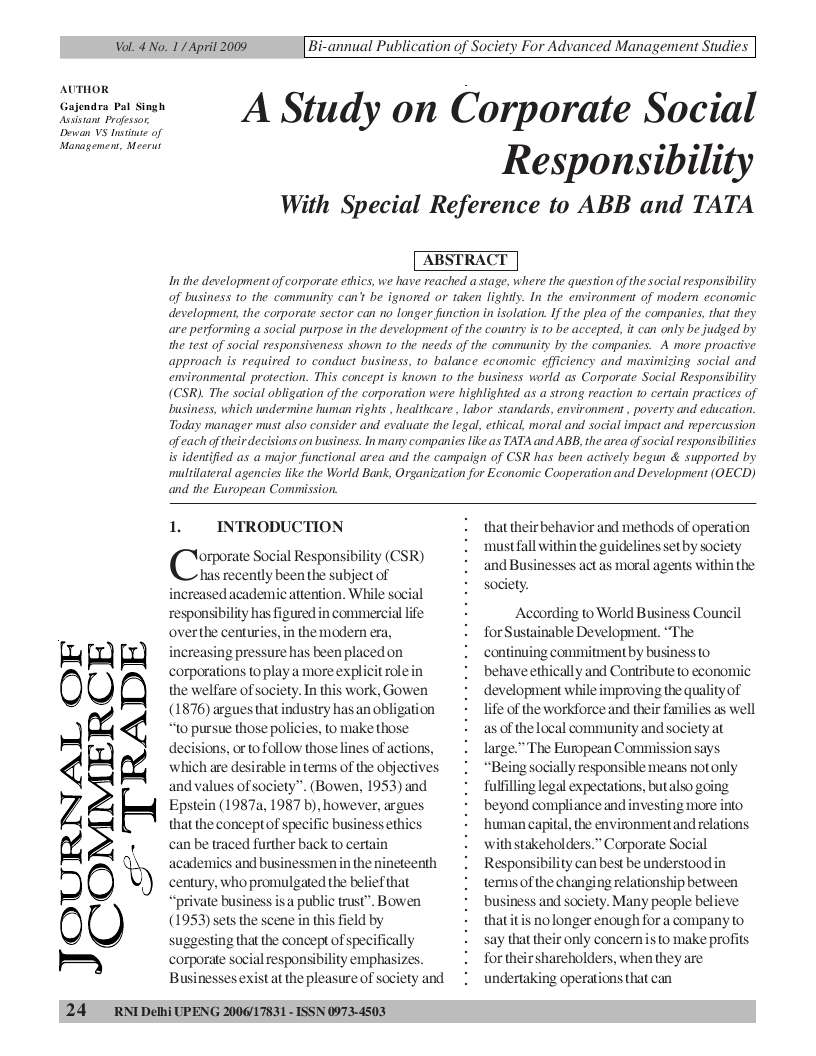A Study on Corporate Social Responsibility (With Special Reference to ABB and TATA)
DOI:
https://doi.org/10.26703/jct.v4i1.407Keywords:
Corporate Social Responsibility, CSR, Indian Industrial Sector, IndiaAbstract
In the development of corporate ethics, we have reached a stage, where the question of the social responsibility of business to the community can’t be ignored or taken lightly. In the environment of modern economic development, the corporate sector can no longer function in isolation. If the plea of the companies, that they are performing a social purpose in the development of the country is to be accepted, it can only be judged by the test of social responsiveness shown to the needs of the community by the companies. A more proactive approach is required to conduct business, to balance economic efficiency and maximizing social and environmental protection. This concept is known to the business world as Corporate Social Responsibility (CSR). The social obligation of the corporation were highlighted as a strong reaction to certain practices of business, which undermine human rights , healthcare , labor standards, environment , poverty and education. Today manager must also consider and evaluate the legal, ethical, moral and social impact and repercussion of each of their decisions on business. In many companies like as TATA and ABB, the area of social responsibilities is identified as a major functional area and the campaign of CSR has been actively begun & supported by multilateral agencies like the World Bank, Organization for Economic Cooperation and Development (OECD) and the European Commission.
Downloads
References
Aupperle,K.E.,Carroll,A.B. and Hatfield J.D.(1985): An Empirical Examination of the Relationship between Corporate social Responsibility and Profitability. Academy of Management Journal,Vol. 28, pp 466-643.
Baxi C.V., Prasad Ajit,:Corporate Socail Responsibility-Concept and Cases, Excel Books, 2006, pp3-19.
Commission of the European Communities (2002) “Communication from the Commission Concerning Corporate Social Responsibility: A Business Contribution to Sustainable Development”, http://ec.europa.eu/employment_social/soc-dial/csr/csr_2002en.pdf.
Dawkins,J.(2004) “ Corporate Social Responsibility : The Communication Challenge”, Journal of Communication Management,Vol.9, No.2, pp.108-119.
Freeman, R.E. (1984): Strategic Management, A Stakeholder Approach. Pitman Publishing, Boston, MA
Kotler , Philip, and Nancy Lee (2005), Corporate Social Responsibility: Doing the Most Good for Your Company and Your Cause, Hoboken, N.J, John Wiley & Sons ,Inc, pp 307.
Lantos , G.P.(2001): “The Boundaries of Strategic Corporate Social Responsibility and Models of Management Morality”, in Richardson , J.E.(Ed.), Business Ethics, pp 198-203.
Porter ,M.E., and M.R.Kramer(2002) “The Competitive Advantage of Corporate Philanthropy”, Harvard Business Review, Vol.80, No.12, pp 56-69.
Wood (1991). “Corporate Social Performance Revisited”, Academy of Management Review, Vol.16, No.4, pp 758-769.

Downloads
Published
Issue
Section
License
Copyright (c) 2009 Gajendra Pal Singh

This work is licensed under a Creative Commons Attribution 4.0 International License.










